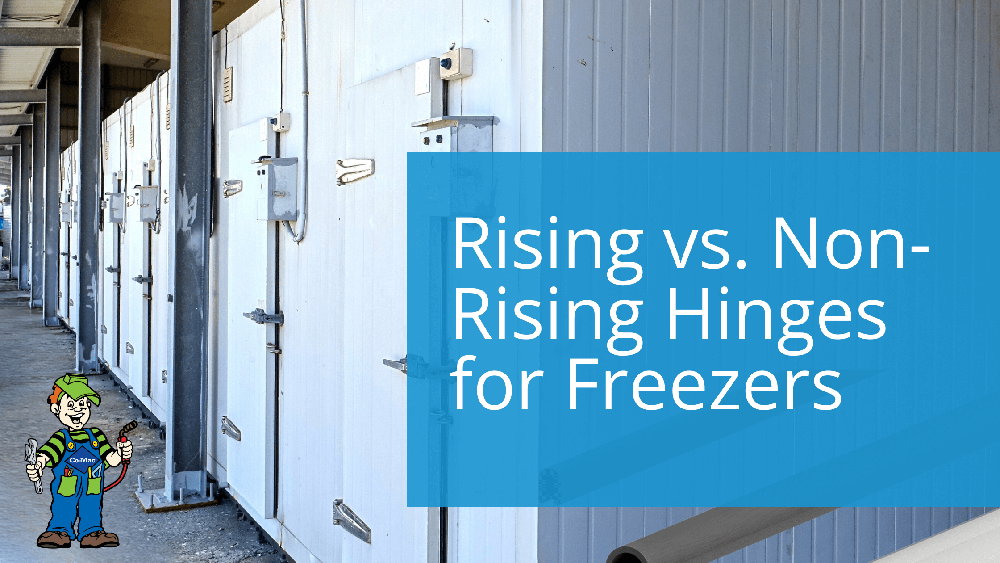Blog
Choosing the Right Hinge for Your Chiller: Rising vs. Non-Rising Hinges
 When constructing or maintaining a chiller, one critical component that often gets overlooked is the choice of hinge. The right hinge can significantly impact the functionality and longevity of the chiller’s door.
When constructing or maintaining a chiller, one critical component that often gets overlooked is the choice of hinge. The right hinge can significantly impact the functionality and longevity of the chiller’s door.Among the options available, rising hinges and non-rising hinges are the two primary types to consider. Understanding the differences between these hinges will help you make an informed decision tailored to your specific needs.
Rising Hinges: Ideal for Specialized Needs
Rising hinges are engineered to allow the door to lift slightly as it opens. This feature is particularly useful in scenarios where the door needs to clear a floor threshold or seal more effectively.
As the door swings open, the rising motion prevents it from dragging on the floor or catching on any obstructions. This can be especially advantageous in commercial environments where heavy doors are common and precise alignment is crucial.
Applications: Rising hinges are well-suited for chillers where the door might face obstacles or where a tight seal is necessary. They provide smoother operation and can extend the lifespan of both the hinge and the door by reducing wear and tear caused by friction.
Non-Rising Hinges: Simple and Cost-Effective
Non-rising hinges, on the other hand, operate with a fixed pivot point. They do not provide any lifting action as the door opens, making them a simpler and more cost-effective option. These hinges are designed for environments where the door operates without obstruction and where additional clearance is not a concern.
Applications: Non-rising hinges are ideal for standard chiller installations where the door can swing freely and no special clearance is required. They offer reliable performance for typical use cases and are generally easier to maintain.
Making the Right Choice
When deciding between rising and non-rising hinges for your chiller, consider the following factors:
- Floor Conditions: If the door will need to clear a threshold or uneven floor surface, rising hinges are likely the better choice.
- Door Weight and Frequency of Use: Heavier doors or those subjected to frequent use may benefit from the additional functionality of rising hinges.
- Cost and Maintenance: Non-rising hinges offer a more budget-friendly option with straightforward maintenance but lack the specialized features of rising hinges.
Ultimately, the choice of hinge will impact both the performance and durability of your chiller. By understanding the advantages of rising and non-rising hinges, you can select the option that best meets your operational requirements and ensures smooth, efficient door function.
Latest Blogs
How to Build Security Sliding Doors for a Outdoor Sports Court? Outdoor Security Sliding Door Project Review. 5931 Beam Clamp Load Testing - Vertical Pull Test | Co-Mac Types of Gate Rollers for U Track: Which One is Right for You? Choosing the Right Hinge for Your Chiller: Rising vs. Non-Rising Hinges Understanding Different Shapes of Seals: A Comprehensive Guide Accelerated Salt Spray Testing of Rust Protection Zinc Paints Top 3 Lock Options for Sliding Doors and Gates Container Door Hardware: A Guide to Container Hinges, Locks and Seals Top Tips for Choosing Durable Sliding Door Hardware in New Zealand's Climate: Your Ultimate Guide Self Closing Gate Hardware In the Community: Picking Daffodils 3 Types of Drop T Latches 2022 Catalogue Coming Soon! How long will Linear Slides last? We tested them past 80,000 cycles - find out how they performed How Long Will a Gas Strut Last? Engineering Forces Explained: Tensile, Compressive, Shear and Torsion Co-Mac Boredom Busters - How We Did It Co-Mac Boredom Busters Is a Double Nut Better than a Single Nut? How much Better?















